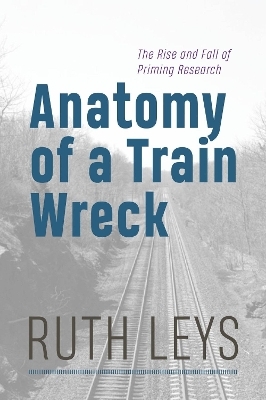
Anatomy of a Train Wreck
University of Chicago Press (Verlag)
978-0-226-83693-5 (ISBN)
In 2012, a team of Belgian scientists reported that they had been unable to replicate a canonical experiment in the field of psychology known as “priming.” The original experiment, performed by John Bargh in the nineties, had purported to show that words connoting old age unconsciously influenced—or primed—research subjects, causing them to walk more slowly. When subsequent researchers could not replicate these results, Nobel-winning psychologist Daniel Kahneman warned of a “train wreck looming” if Bargh and his colleagues could not address doubts about their work. Since then, the inability to replicate other well-known priming experiments has helped precipitate an ongoing debate over what has gone wrong in psychology, raising fundamental questions about the soundness of research practices in the field.
Anatomy of a Train Wreck offers the first detailed history of priming research from its origins in the early 1980s to its recent collapse. Ruth Leys places priming experiments in the context of contemporaneous debates over not only the nature of automaticity but also the very foundations of social psychology. While these latest discussions about priming have largely focused on methodology—including sloppy experimental practices, inadequate statistical methods, and publication bias—Leys offers a genealogy of the theoretical expectations and scientific paradigms that have guided and motivated priming research itself. Examining scientists’ intellectual strategies, their responses to criticism, and their assumptions about the nature of subjectivity, Anatomy of a Train Wreck raises crucial questions about the evidence surrounding unconscious influence and probes the larger stakes of the replication crisis: psychology’s status as a science.
Ruth Leys is professor emerita of the humanities at Johns Hopkins University. She is the author of Trauma: A Genealogy, From Guilt to Shame: Auschwitz and After, The Ascent of Affect: Genealogy and Critique, and Newborn Imitation: The Stakes of a Controversy.
Acknowledgments
Introduction
Prime Time in Social Psychology
The Replication Crisis
“If you want to understand any scientific work properly, you need to know its history”
Basic Assumptions
Outline of the Book
1. The Rise of Attribution Research
Fritz Heider and the Causes of Social Interaction
The Contributions of Edward E. Jones and Keith E. Davis to Attribution Research
Harold Kelley and the Situation/Disposition Debate
The Growth of Attribution Research
“Telling More Than We Can Know”: Attribution and the Limits of Introspection
The “Why” Question: Are Reasons Causes?
2. Intentions and Causes
“Baseball and Hot Sauce”
Reasons versus Causes
Anscombe versus Davidson on Intentional Action
Agent Causation versus Event Causation
Does Social Psychology Need a New Paradigm?
The Two Social Psychologies, or, Whatever Happened to the Crisis?
3. John Bargh’s Approach to Automaticity
Subliminal Perception Becomes “Unconscious Priming”
Is Automaticity Its Own Thing, and If Not, What Is the Recipe?
A Features or Graded Approach to Automaticity?
Bargh’s Auto-motive Theory, or, How Intentions and Goal Pursuits Came Apart
Prinz’s Ideomotor Theory of Automaticity
Does the Environment Trigger Goal Pursuits Independently of Intentions?
The Elderly Priming Experiment
4. “The Unbearable Automaticity of Being”
Bargh’s Manifesto
The Automaticity of Everyday Life
Automaticity, Attention, and Control
Skilled Action
Must Automatic Actions Be Inflexible?
5. The Chameleon Effect
Postural Mimicry and Automaticity
Imitation as an Intentional-Communicative Action
Imitation When We Are Alone
How Bargh and Chartrand Misunderstood Bavelas’s Experiments
The Limits of Contagion
Emotional Mimicry
The Contextual Sensitivity of Mimicry
The Sociality of Chameleons, or, The Watching Eyes Effect
Alan Alda’s Intentions
6. A Theory in Crisis?
Unconscious Thought Theory
The “One-to-Many” or “Many Effects of One Prime” Problem
Bargh under Fire and the Problem of Selectivity
The Power of the Situation
Agency and the Legacy of Cognitive Psychology
7. The Fate of Priming
Doyen et al.’s (2012) Failed Replication and Its Aftermath
Hidden Moderators: “The Ultimate Attribution Error”?
The Historical Sensitivity of Priming Outcomes
“There might be deep and substantive limits to both the replicability and the generalizability of . . . social priming effects”
8. “Behavioral Priming: It’s All in the Mind, but Whose Mind?”
Experimenter Expectancy
What Explains Experimenter Expectancy and Demand Effects?
Kenneth Bowers’s “Dissociated Control” Theory of Hypnosis
“The question ‘Why’ has and yet has not application”
Bargh on Priming and Hypnosis
Priming and Expectancy Effects
The Long Legacy of Nisbett and Wilson (1977): What Is Consciousness For?
Consciousness as Rationalization
Conclusion: The Two Camps
Appendix: Bargh on Unconscious Intentionality
References
Index
| Erscheinungsdatum | 01.11.2024 |
|---|---|
| Sprache | englisch |
| Maße | 152 x 229 mm |
| Gewicht | 454 g |
| Themenwelt | Geisteswissenschaften ► Psychologie ► Allgemeine Psychologie |
| Geisteswissenschaften ► Psychologie ► Verhaltenstherapie | |
| ISBN-10 | 0-226-83693-2 / 0226836932 |
| ISBN-13 | 978-0-226-83693-5 / 9780226836935 |
| Zustand | Neuware |
| Informationen gemäß Produktsicherheitsverordnung (GPSR) | |
| Haben Sie eine Frage zum Produkt? |
aus dem Bereich


